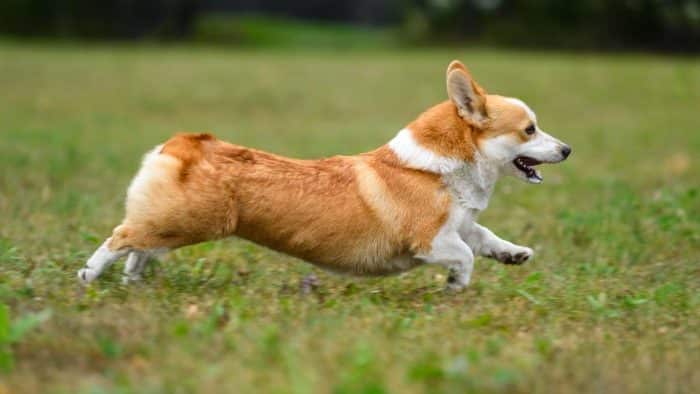- Not a substitute for professional veterinary help.
Historically, it was common for many puppies to get a surgery called tail docking. This procedure, which shortens the tail, typically happens in the first week of a puppy’s life.
Tail docking was considered a preventative measure to reduce the likelihood of injuries, says Dr. Georgina Ushi, a veterinarian in Tampa Bay, Florida.
Yet while this medical procedure is painful and can cause serious complications, it’s not always performed in a veterinarian’s office under anesthesia.
“Some veterinarians and breeders will place a ligature (like a rubber band) to cut off blood supply to the tail until it naturally falls off, usually within a few days,” Dr. Ushi explains. More commonly, the tail is cut with a surgical instrument and closed with stitches, tissue glue, or left to heal naturally.
Current research suggests this procedure is unnecessary, and ethical concerns around tail docking continue to grow. As a result, many pet parents feel more hesitant about the procedure and its impact on their pups’ well-being.
Why Do People Dock Dogs’ Tails?
The practice of tail docking is centuries old, and some historical records suggest dogs in ancient Roman, Greek, and Egyptian civilizations had their tails docked.
Tail docking is usually reserved for dogs with jobs, like Doberman Pinschers, Boxers, Rottweilers, Cocker Spaniels, and Schnauzers.
Various historical reasons for this procedure include:
- Misconceptions: People once believed sheepdogs’ long tails would get in the way of their ability to smell when they curled up to sleep. In Rome, people believed removing the tail (and part of the tongue) would keep a dog from getting rabies.
- Tax avoidance: In England, people docked their dogs’ tails to avoid a non-working dog tax.
- Preventing injuries: Docking may reduce tail injuries during hunting and work in dense vegetation.
- Household safety: Some believe docking prevents injuries caused by wagging and smacking into household objects. But one study found that dogs only have about a 0.23% risk of tail injuries from things like whacking their tail on household items or getting their tail caught in a door.
- Improved hygiene: Some supporters of docking say the practice can reduce the risk of poop sticking to your dog.
- Aesthetics and tradition: Tail docking is an aesthetic breed standard for many dogs. Since 1976, however, the American Veterinary Medical Association (AVMA) has urged breed clubs to remove cosmetic alterations like docking from breed standards.
Tail docking isn’t always a pet parent’s choice. Ushi says many breeders will dock a puppy’s tail before selling them.
Is selective breeding the same as docking?
Selective breeding is the practice of breeding dogs to produce puppies with specific traits. You might also know these hybrid pups as “designer dogs.”
People have selectively bred dogs to get low-shedding dogs for people with allergies and birding dogs who excel in hunting. But sometimes, exaggerating physical features through breeding can lead to negative health consequences, like gene mutations that affect a dog’s health.
Some dogs have been selectively bred to have a bobbed tail. Puppies who have at least one of these breeds as a parent are more likely to have a naturally short tail.
The 20 dog breeds carrying the bobtail gene include:
- Australian Cattle Dog
- Australian Shepherd
- Austrian Pinscher
- Bourbonnais Pointer (Braque du Bourbonnais)
- Brazilian Terrier
- Brittany Spaniel
- Catahoula Leopard Dog
- Croatian Sheepdog
- Danish/Swedish Farmdog
- Jack Russell Terrier
- Karelian Bear Dog
- McNab
- Mudi
- Pembroke Welsh Corgi
- Polish Lowland Sheepdog
- Pyrenean Shepherd
- Savoy Sheepdog
- Schipperke
- Spanish Water Dog
- Swedish Vallhund
Docking vs. tail amputation
Tail amputation, also known as caudectomy, is the surgical removal of part or all of a dog’s tail by a licensed vet.
“There are definitely medical reasons to amputate tails,” says Dr. Katie Kangas, veterinarian and founder of The Pet Wellness Academy. Some of these reasons include:
- Severe injury
- Disease, such as cancerous growths
- Congenital malformations like an ingrown tail (also called screw-tail or corkscrew tail)
This surgery is only performed medically necessary, under anesthesia, by a licensed vet.
Do Dogs Need Tails?
A dog’s tail is pretty essential, in part because they help dogs communicate.
“Dogs show their emotions and intentions through tail wagging and how their tail is positioned (up, down, or arched),” Dr. Ushi says.
Dogs who don’t have tails can still communicate through other forms of body language, like ear position, facial expressions, and posture. Some tailless dogs also “wag” their rear ends to communicate.
Still, tails have other functions, too. As an extension of the spine, they help dogs balance, and they also come in handy for swatting away pests.
Is Tail Docking Ethical?
Many organizations oppose tail docking for cosmetic reasons due to the lack of proven health benefits and the potential for pain and suffering during the procedure and recovery. These organizations include:
- AVMA
- Animal Humane Society (AHS)
- American Animal Hospital Association (AAHA)
- People for the Ethical Treatment of Animals (PETA)
“It’s controversial because anesthesia is rarely used in puppies for this procedure due to their young age. There are also not a lot of options for pain control in young puppies except for a local anesthetic,” explains Dr. Dwight Alleyne, a veterinarian at PetFolk and JustAnswer companion animal expert.
Many countries, including most of the European Union, Australia, Iceland, and Norway, among others, have banned or heavily restricted tail docking for cosmetic reasons.
The United States has yet to follow these examples, however. Only Pennsylvania and Maryland have restrictions on tail docking, and the American Kennel Club (AKC) opposes stricter regulations.
Dr. Ushi says, however, that some vets and vet students refuse to learn or perform certain cosmetic procedures like tail docking.
Preventing tail docking
Dr. Ushi shares a few steps that can promote responsible breeding practices and the well-being of dogs historically subjected to tail docking:
- Education and awareness: Learn about tail docking procedures, ethical concerns, and the potential impact on dogs’ well-being. Talk about the issue with breeders, pet parents, and the general public. If you’re considering purchasing a dog from a breeder, ask about the their tail docking policy and whether you can opt out of the procedure for your puppy.
- Breed standards reform: Advocate for revisions to breed standards that prioritize a dog’s health and welfare over their cosmetic appearance. Encourage breed clubs and organizations to adopt standards that allow natural tails and discourage or ban tail docking.
- Legislative advocacy: Support legislation and regulation that restricts or prohibits tail docking.
Should You Dock Your Dog’s Tail?
Ultimately, you’re the only one who can decide whether to dock your dog’s tail or not.
If you’re considering this procedure, a good first step involves talking to your vet. They can give you more information about the effects tail docking could have for your dog and potential pros and cons of the procedure.






